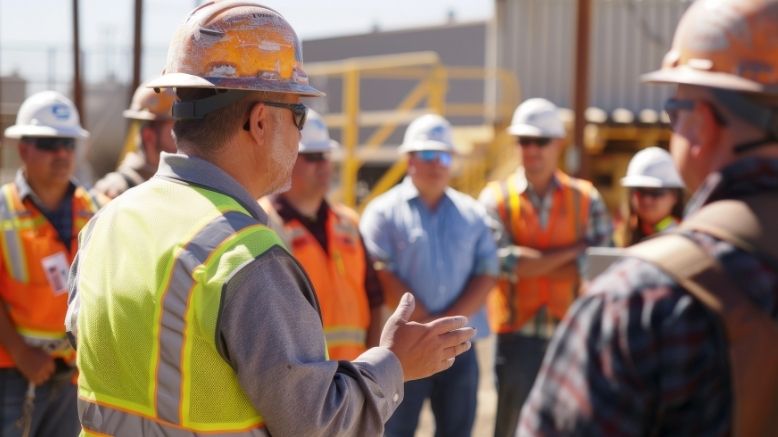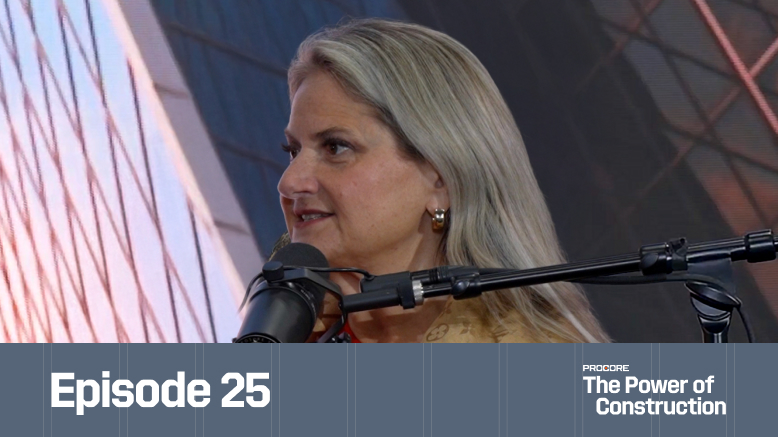— 6 min read
A Contractor’s Guide to Working With Construction Union Labor


Last Updated Oct 3, 2025

Janine Trinidad
Staff Trainer and Program Manager
25 articles
Janine Trinidad is a Construction Educational professional for Procore Technologies. In previous roles, Janine managed all phases of construction on hotel, mixed-use, and institutional projects in the San Francisco Bay area. She was responsible for negotiating contract budgets and change orders, managing RFIs and submittals, and overseeing quality control, among other duties. She is also a certified transformational coach with a focus on women-centered and trauma-informed methods. She is passionate about transforming the construction industry to be a healthier, more successful and welcoming place to work and believes technology and education are allies in doing so.

Kristen Frisa
Contributing Writer
111 articles
Kristen Frisa is a contributing writer for Procore. She also contributes to a variety of industry publications as a freelance writer focused on finance and construction technology. Kristen holds a Bachelor of Arts in Philosophy and History from Western University, with a post-graduate certificate in journalism from Sheridan College. She lives in Ontario, Canada.
Last Updated Oct 3, 2025

In the construction industry, unions play a critical role, bringing together laborers and tradespeople such as plumbers, carpenters or masons under collective bargaining agreements with employers. These agreements set the terms of employment, including wages, hours and working conditions.
This article will discuss the considerations and nuances of working with union labor on a construction job.
Table of contents
What is a construction union?
A construction union is an organized group of construction workers, tradespeople and/or laborers who collectively enter into bargaining agreements with employers or employing entities. This collective bargaining process allows the union to negotiate wages, working conditions and other employment terms on behalf of its members.
In the construction industry, unions often represent specialized crafts or trades, such as plumbers, carpenters and electricians, and work to ensure that their members receive fair pay, benefits and safe working conditions. Members of construction unions pay dues to the organization, and in return, they receive representation and various forms of support from the union, including assistance with training, job placement, and dispute resolution.
How is union labor different?
Although managing union and non-union labor looks very much the same, there are some differences that contractors should consider when working with a union.
The main thing to remember is that a general contractor who employs union labor on a project must work to understand what the union labor requirements are and meet them, in addition to any federal, state, and municipal-level requirements.
Unlike many non-union skilled tradespeople, union members are often considered independent contractors — meaning, when a subcontractor hires union labor for a specific job, those workers aren't considered employees of that company. That being said, this isn’t a rule — many contractors hire union members as W2 employees.
When contractors say they have to hire from the hall, they mean that they plan to use union labor for a particular job, and will contact the union to get in touch with individuals. If a contractor is a signatory to a union, all of their employees performing that union’s jurisdictional work must pay union dues. Failure to pay those dues might result in disputes with the union.
Contractors and project managers must be aware of the complexities of this relationship, including the handling of payroll and tax implications, which may necessitate specialized accounting expertise.
Wages
Unions often have certain wage rate requirements that contractors must follow when working with union labor. Wage rate rules will be very specific to the jurisdiction and changes to these rates typically are announced with a labor bulletin. Knowing when these labor bulletins are typically published will help a contractor anticipate impacts on job cost and negotiate that with the owner.
Hours
Along with wage rates, unions often dictate rules about wage hours. The union agreement may also define what constitutes regular paid hours, when weekly hours slip into overtime, what hours qualify for double-time wages, and any other restrictions related to being on the job, like breaks and start/stop times or holidays. Contractors should work these stipulations into both the schedule and budget before work begins.
Dues
Often, union laborers participate in "dues checkoff," meaning the employing contractor deducts the union dues from their paychecks and forwards it to the union. Contractors need to understand union dues to make sure that each union laborer employed on the job is in good standing.
Hiring and training
Contracting union labor may require the use of certain hiring methods or channels, as dictated by the union. Union halls often work through a referral system and apprenticeship programs to help match contractors up with qualified workers. Unions may dictate certain training paths so that their laborers learn the skills they need to be successful on the job and throughout their careers.
Safety
Unions may require contractors to agree to safety protocols above and beyond OSHA safety requirements, or they may require contractors to follow specific protocols around safety hazards they want to be addressed. An example might be the elevator union requiring no one else in the elevator lobby during installation work due to the high safety risks of having an open pit.
Scope of work
Laborers' jobs are clearly outlined in the contract they sign when hired on a construction project. If the project includes a scope of work that a unionized workforce is able to do, but for some reason they're not doing it on a project, it could be a big source of dispute. Likewise, union workers should be cautious not to expand outside their scope of work without prior agreement.
If a worker does a small amount of work that's outside of trade by a tiny margin or understood as general and non-specialized, it won't often cause too many ripples. However, if that worker starts to do a large scope of work outside of trade it might start to raise eyebrows because it may appear as though one trade worker is taking work away from another.
Cleanup is a good example of when this clash may come to bear. Contractors should be aware of how each union defines "cleanup" within each trade's scope of work. While each trade can be responsible for its own tidying on the jobsite, project-wide cleanup may be better left to the laborers' union or whichever union has claimed that work.
Any jurisdiction dispute is not only about one person doing a job — it's also about the value that work brings to the project and how it translates to job cost. Therefore, working with unions and knowing how they work is not only important during the construction phase when employing union workers but also critical during preconstruction when estimating the labor cost for the project.
Tool tip: A free Labor Cost Calculator makes it easy to estimate your labor costs for any project.
Terminations
As with any employment position, a union worker may be fired for cause. However, there may be more stipulations around the termination of a union worker. Further, if the worker disputes the cause, a union representative may challenge the action.
While managing union workers is much like managing any other labor on the jobsite, contractors and their project managers must remember that the union represents another entity that it has to interface with when it comes to union workers.
Imposed consequences on behalf of the worker
Union workers enter into a collective bargaining agreement so that they can have the people power to set expectations for the working environment and experiences. If a union worker decides the contractor isn't following union rules, that worker can file a complaint with the union, who will approach the contractor about the breach. In cases of serious violations or if the union isn't satisfied the contractor is fixing the problem, the situation could result in a refusal to work and potentially risk the progress of the project.
Understanding Union Rules
A greater understanding of how to manage the intricacies of union labor will offer better chances of avoiding hiccups to that could potentially delay the job and cost a lot of money. If a union does decide the contract team has not followed the rules, they have the ability to stop the work until the dispute is solved, which could delay the job by days, weeks or even months.
Project managers new to working with construction unions should do their research at the local level and ask lots of questions to develop a full understanding of expectations. Have a conversation with executives or someone experienced in managing union work to get an idea of what past relationships or methods ensure success and how to emulate them.
NOV 6, 2025 at 11:00 AM PST / 2:00 PM EST
Free Webinar: Prove your project management software is profitable
Join Procore and Dodge Data & Analytics for a 2025 Dodge ROI Report deep dive.

Was this article helpful?
Thank you for your submission.
94%
6%
You voted that this article was . Was this a mistake? If so, change your vote
Scroll less, learn more about construction.
Subscribe to The Blueprint, Procore’s construction newsletter, to get content from industry experts delivered straight to your inbox.
By clicking this button, you agree to our Privacy Notice and Terms of Service.
Thank you!
You’re signed up to receive The Blueprint newsletter from Procore. You can unsubscribe at any time.
Categories:
Written by

Janine Trinidad
Staff Trainer and Program Manager | Procore Technologies
25 articles
Janine Trinidad is a Construction Educational professional for Procore Technologies. In previous roles, Janine managed all phases of construction on hotel, mixed-use, and institutional projects in the San Francisco Bay area. She was responsible for negotiating contract budgets and change orders, managing RFIs and submittals, and overseeing quality control, among other duties. She is also a certified transformational coach with a focus on women-centered and trauma-informed methods. She is passionate about transforming the construction industry to be a healthier, more successful and welcoming place to work and believes technology and education are allies in doing so.
View profile
Kristen Frisa
Contributing Writer | Procore
111 articles
Kristen Frisa is a contributing writer for Procore. She also contributes to a variety of industry publications as a freelance writer focused on finance and construction technology. Kristen holds a Bachelor of Arts in Philosophy and History from Western University, with a post-graduate certificate in journalism from Sheridan College. She lives in Ontario, Canada.
View profileExplore more helpful resources

Defending Against Financial & Legal Risks on Megaprojects
The construction industry has seen marked growth in megaprojects. Some experts classify any project over $500 million as a megaproject, while others argue that the build needs to be $1...

Unlocking Project Intelligence: Moving from Raw Data to Actionable Insights
The construction industry faces a wide range of challenges, from ongoing labor shortages to frequent cost overruns. But some the biggest hurdles all stem from unpredictability. The general contractors (GCs)...

Who is accountable for innovation in construction?
Everyone says construction needs to innovate—but no one agrees on who’s actually responsible for making it happen. Is it the owner? The builders? The tech vendor? Or is innovation everyone’s...

Integrated Project Delivery in Practice: A Framework for Collaboration
On construction projects, traditional delivery methods put different stakeholders in their own silos. While the design team feeds drawings and specifications to the general contractor (GC), the GC’s expertise in...
Free Tools
Calculators
Use our calculators to estimate the cost of construction materials for your next project.
Templates
Find a template to help you with your construction project tasks.
Material Price Tracker
Get the latest U.S. retail prices and view historical trends for common building materials.
Glossary
Explore key terms and phrases used in the industry.
